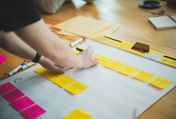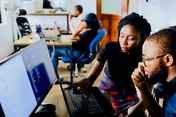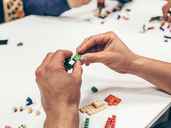Creating prototypes
The next step is to test whether potential ideas, prototypes, models or pilots work as planned or in surprising ways.
Prototypes are typically low-cost models that can be quickly developed for trial and feedback. They are iterated with trial, learning, evaluation and course-correction along the way. This kind of real-time assessment is the most efficient way to gather the evidence you need to either quickly abandon an unworkable or untimely approach or make the case for its expansion.
Developmental evaluation is a process of learning as you go. The traditional approach to running an experiment is to follow fixed processes for a predetermined time and measure the results. The problem with using this approach to bring about social change is that it is often slow and cumbersome. It might be clear after relatively little time that what you are doing is not working, so completing the experiment as designed may be scientifically pure but practically wasteful. It is better to pay close attention to what is working, what is not, and what new information has emerged as you go. Doing so allows you to remain agile and redesign the project as you learn more, increasing the chances of reaching your goal, rather than veering irreparably off course or persisting with an idea that is not working.
Scaling up or moving on
When you finish testing your prototype, you have decisions to make. Was it a roaring success that with relatively few tweaks is ready to go further? Or was there enough that worked well that you could apply it to a new, revised approach? Alternatively, did it fail to meet expectations, no matter how well it was implemented? All of these results are successes, as they point clearly to the next best step.
Scaling up a successful project can happen in stages or all at once. The decision depends on a variety of factors:
- How clear was the outcome?
- What more is there to be learned?
- Are the conditions in place to expand the prototype?
- How much will it cost?
- Have you convinced the decision-makers to proceed?
- What are the risks of moving too quickly?
- What are the risks of moving too slowly?
- Can funding be found?
- Are the partners necessary to deliver it onboard?
- Is the prototype sustainable? Or can it be made to be over time?
If your prototype isn’t successful and can’t be made so with minor adjustments, the exercise should still be considered a success. Document what you have learned. It will prevent others from repeating things you have already tried, potentially point you to a new direction and equip you with new knowledge you need to succeed. Moving on from a prototype makes room for something better to emerge. Celebrate this too – it was the intention all along.
Repeating the data cycle
Once you have travelled around the data cycle, it is time to start over again. Research is most powerful when it is repeated on a reliable and regular schedule. The differences in findings from one survey to the next enable a deeper level of understanding of progress and emerging challenges and provide a context for your actions. With luck, steps you have taken have contributed to measurable improvements. No matter what, you will be closer to identifying strategies that work. Knowledge builds upon knowledge and propels us with wisdom and strength toward change.
Back to the start
Now you are prepared to decide if you are ready to bring the Community Child and Youth Well-being Survey to your community. The next step is to contact UNICEF Canada to review and discuss the requirements within the licensing agreement. With the signing of the licensing agreement, you are ready to start the data cycle. We encourage you to network with other communities on this survey journey. Thank you for your interest, enjoy the journey and please share what you learn along the way. Together, we can make a real difference in the lives of children and youth across Canada.





































